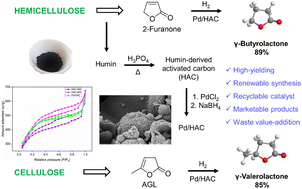Renewable synthesis of γ-butyrolactone from biomass-derived 2-furanone using palladium supported on humin-derived activated carbon (Pd/HAC) as a heterogeneous catalyst
Abstract
This work reports a high-yielding synthesis of γ-butyrolactone (GBL), a promising biofuel, renewable solvent, and sustainable chemical feedstock, by the catalytic hydrogenation of 2-furanone. 2-Furanone can be synthesized renewably by the catalytic oxidation of xylose-derived furfural (FUR). Humin, produced during the preparation of FUR from xylose, was carbonized to form humin-derived activated carbon (HAC). Palladium supported on humin-derived activated carbon (Pd/HAC) was used as an efficient and recyclable catalyst for hydrogenating 2-furanone into GBL. The process was optimized in various reaction parameters, such as temperature, catalyst loading, hydrogen pressure, and solvent. Under optimized conditions (RT, 0.5 MPa H2, THF, 3 h), the 4% Pd/HAC (5 wt% loading) catalyst afforded GBL in an 89% isolated yield. Under identical conditions, an 85% isolated yield of γ-valerolactone (GVL) was obtained starting from biomass-derived angelica lactone. Moreover, the Pd/HAC catalyst was conveniently recovered from the reaction mixture and successfully recycled for five consecutive cycles with only a marginal decrease in the yield of GBL.



 Please wait while we load your content...
Please wait while we load your content...